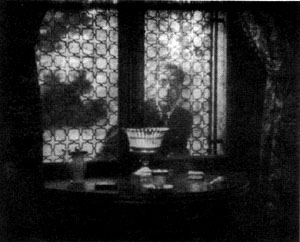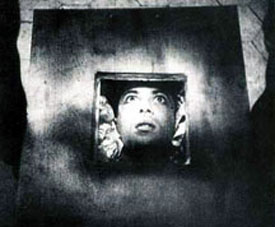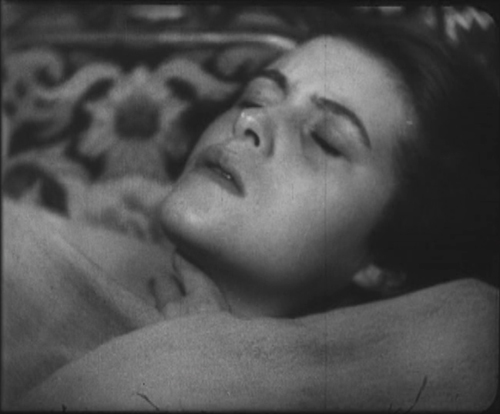This review from the August 1976 issue of Monthly Film Bulletin may represent my most exhaustive (and exhausting) attempt to extend the one-paragraph review format of that magazine almost to the point of infinity. — J.R.
Vampyr: Der Traum des Allan Gray (Vampyr: The Strange Adventure of David Gray)
Germany/France, 1932
Director: Carl Th. Dreyer
Cert — A. dist –– Cinegate. p.c –- Tobis-Klangfilm-France (Berlin-Paris)/Dreyer Filmproduktion (Paris). p –- Carl Th. Dreyer, Baron Nicolas de Gunsburg. asst. d –- Ralph Holm, Éliane Tayara, Preben Birck. sc -– Carl Th. Dreyer, Christen Jul. Inspired by the collection of stories In a Glass Darkly by Sheridan Le Fanu. ph -– Rudolph Maté, Louis Née. ed –- Carl Th. Dreyer. a.d –- Hermann Warm, Hans Bitman, Cesare Silvagni. m -– Wolfgang Zeller. English titles -– Herman G. Weinberg. sd -– Hans Bittman. Post-synchronisation -– Paul Falkenberg. l.p -– Julian West [Baron Nicolas de Gunzberg] (David Gray), Henriette Gérard (Marguerite Chopin), Sybille Schmitz (Léone), Renée Mandel (Gisèle), Maurice Schutz (Lord of the Manor), Jan Hieronimko (Doctor), Jane Mora (Nurse), Albert Bras and A. Babanini (Servants at the Manor). 6,130 ft. 68 min. English titles.
David Gray arrives on holiday at an inn by a river in the village of Courtempierre. After overhearing faint voices outside his room, he locks his door and goes to bed, but is woken later by a stranger who enters mysteriously, alludes to a woman who “mustn’t die”, ahd leaves behind a parcel to be opened after his death. Going out himself, Gray follows the shadow of a one-legged soldier into an abandoned mill where he sees it sit down beside the soldier himself until an old woman calls the shadow away. He also encounters the shadows of couples dancing to an orchestra, and glimpses an empty coffin, a laboratory and a doctor who receives a vial of poison from the old woman. Wandering to a nearby manor, where a young woman named Léone is suffering from a loss of blood while her sister Gisèle helps care for her, Gray sees their father – the man who gave him the parcel – shot by the soldier’s shadow (now upside-down), and rushes inside to attend to the dying man with the help of servants, one of whom is sent off to inform the police. Opening the parcel, he finds a book of vampire lore. Léone is discovered missing; Gray and Gisèle find her outside – with an old woman bent over her, who quickly retreats – and she is brought back to the manor. Léone awakens with a wound in her throat to gaze at Gisèle in carnal lust; the messenger sent to the police then returns in his carriage, dead. The doctor arrives; Gray gives blood to Léone and then sleeps while a servant reads in the vampire book about Marguerite Chopin, an evil and unrepentant woman believed to be the local vampire who is buried in the village cemetery. Waking, Gray prevents . Léone from taking poison and struggles with the doctor before running outside and collapsing; he appears to dream that he sees Gisèle as a prisoner in the mill and himself being carried off in a coffin by the soldier, doctor and old woman. Waking, he helps a servant drive an iron spike through the corpse of Marguerite Chopin, which turns into a skeleton, and Léone instantly revives. In the mill, menaced by shadows and the face of the dead lord of the manor, the soldier dies mysteriously. Gray arrives to free Gisèle, and while the couple proceed in a boat across the river to safety, the doctor is buried alive in flour after the mill machinery is set into motion.
If there are few films in narrative cinema as inimical to the notion of a synopsis as Carl Dreyer’s Vampyr, this is essentially because the narrative conventions that it uses are present only to be contested and dismantled. Missing from the abbreviated summary above, for example, is the shadow image of a grave being dug in reverse, which appears both before and after David Gray first enters the `abandoned’ mill, thus isolating itself from the fixed reference of any character’s point of view or any consistent pattern of chronology or temporality. If one assumes in retrospect that this shot refers to the unearthing of Marguerite Chopin, one is immediately confounded by the fact that she is seen in the mill just before the shot is repeated, and the fact that its action is shown in reverse remains as unexplained as the appearance of the soldier’s shadow upside-down when it shoots the lord of the manor with a rifle. As Noël Burch and Jorge Dana have usefully indicated in Afterimage No. 5, the entire film can be analyzed in terms of a deliberate breakdown of the codes governing separations of `subjective camera’ and `objective camera’ and logical or temporal assumptions made about crosscutting. Considering the difficulties this poses, it is hardly surprising that most commentators have implicitly sought to simplify the film’s language, either by interpreting its formal anomalies as `mood’ or ‘background’ or by ignoring them entirely. But the stunning paradox of Dreyer’s masterpiece is that it pursues elusiveness via a concrete route whereby materialism and eroticism become two sides of the same coin, and the uncanny is conveyed through a very solid sense of flesh. This is accomplished in a number of ways, each of which entails the disruption of a language pattern in order to assert corporeal presences beyond the formal co-ordinates which initially define and enclose them: a process involving objects as well as people, which is startlingly echoed in the erotic dislocations of Jacques Rivette’s most recent film, Duelle. This is not merely a matter of shattering various thematic taboos and conventions — as in the remarkable close-ups of Léone in full-face and profile, smiling lasciviously at her beautiful sister and showing her teeth until her expressions progress to a more hostile and furtive form of desire –- but a procedure involving the very mechanics of narration itself. Thus in the celebrated `dream’ sequence during which David Gray splits into two selves so that his transparent half can observe yet another version of himself inside a coffin, the action is divided into shots representing the viewpoints of (1) the transparent Gray, (2) the characters standing over the coffin, and (3) Gray inside the coffin; and while the funeral procession is basically depicted through the alternation of (3) with reverse-angles of Gray through the coffin window, this pattern is itself broken by a brief upward pan across the outside of the manor seen right-side up, in contrast to the low unorthodox angles of the same building as `seen’ by Gray inside the coffin. Turning to Dreyer’s script, we also find that the transparent Gray’s discovery of Gisèle during this sequence is meant to be no less `real’ than its subsequent repetition after he wakes: Gray’s hands loosening her binds the second time “are taken as in the previous shot, i.e. in such a way that the spectator is uncertain whether they are real or not”. An example of comparable disorientation occurring within a single shot can be found in a forty-four second take charting the return of Léone to the manor. Inside, the camera pans from a character seen through a window to a door as she passes through it, continuing past another window through which we glimpse the servants carrying Léone, and traversing the room’s interior until it reaches a hallway, whereupon it tracks backward through it and an adjoining room while a servant enters at left to assist the servants entering the hallway with Léone at right, and proceeds ahead of all these characters before turning left to frame Gisèle and Gray watching from the stairway, and then right again –- after Gisèle and the others go up the stairs -– to follow Gray as he leaves in the opposite direction. A continuous betrayal of expectations in relation to `point of view’, this camera movement accompanies fragments of the diverse trajectories of all the characters in the shot (excepting only Gisèle) while obeying a precise narrative logic of its own –- a logic, one should add, which subsumes a passing `identification’ with each character in terms of camera movement or placement while existing quite independently of all of them. Working hand in hand with such visual strategies are the various distancing devices in the film’s prodigiously composed soundtrack, which enlarges one’s comprehension of the visual space not merely through a rich aural texture of various human and non-human presences outside the frames, but also by occasionally contradicting one’s grasp of what is visible, e.g. the deliberately disembodied and far-off sound of Gisèle calling “Léone!” as she runs about in search of her sister. It is significant that Straub, a filmmaker with a pronounced materialist bias for direct sound, has stated that the completely post-synchronized Vampyr remains for him “le plus sonore de tous les films“, and worth recalling that Dreyer insisted that all his actors dub their own voices in the separate French, German and English versions made of the film, regardless of whether they understood the language or not. (The print under review is in German, except for two brief portions of dialogue from the English version.) And the unnerving complicities established by the film between night and day, human and animal, spirituality and physicality, hunger and lust are matched by the process through which voices and other natural sounds become virtually indistinguishable from Wolfgang Zeller’s music. In the final sequence, which cuts repeatedly between the musty whiteness of the doctor being buried alive in flour and the `impressionist’ greyness of the couple’s escape across the river, the percussive throbbing of the mill’s machinery acts as a literal counter-theme to the strings’ sustained chords accompanying Gray and Gisèle’s progress, along with their remote, echoing calls for help (“Hal-lo! Hal-lo!”) — a relentless rhythmical pattern on the one hand, an open and unresolved suspension on the other. Dreyer’s extraordinary achievement is to apply this paradigm to the film at every level, with a `closed’ world of fate and an `open’ world of freedom perpetually counterposed, each unmasking the other to create an exalted realm where the natural and supernatural, the physical and the metaphysical can breathe the same enlightened air.




